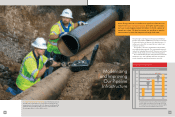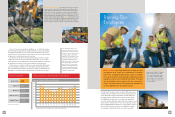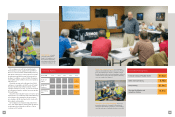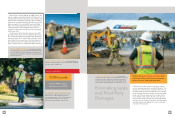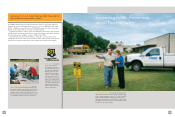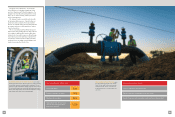Atmos Energy 2015 Annual Report Download - page 13
Download and view the complete annual report
Please find page 13 of the 2015 Atmos Energy annual report below. You can navigate through the pages in the report by either clicking on the pages listed below, or by using the keyword search tool below to find specific information within the annual report.
23
Outlook
We will continue to execute our strategy of growth by
investing in our existing assets.
Our announced guidance for earnings per diluted
share in fiscal 2016 ranges between $3.20 and $3.40,
excluding unrealized margins. Contributions to net income
from regulated operations are forecast to be between
$315 million and $355 million, and net income from
nonregulated operations is expected to be in the range of
$14 million to $19 million.
We operate approximately 76,000 miles of distribution
and transmission pipelines and more than 3.1 million
service lines connected to customers’ premises.
Our primary focus is to replace as soon as possible
all the remaining cast iron pipe in our system and to
evaluate for replacement all existing bare steel pipelines.
In addition, our modernization program will continue to
emphasize the replacement or fortification of older coated
steel pipelines and early-vintage plastic pipe.
We have replaced nearly 1,000 miles of cast iron, bare
steel and early-generation plastic pipe since 2010, and we
expect to double our replacement mileage during the next
five years.
We project our capital expenditures in fiscal 2016 to
be between $1.0 billion and $1.1 billion and our annual
capital expenditures from fiscal 2017 through fiscal 2020
to range between $1.1 billion and $1.4 billion.
Our total regulated rate base value is expected to grow
at a compounded annual growth rate between 9 percent
and 10 percent, from approximately $5.5 billion at year-
end of fiscal 2015 to between $8.5 billion and $9.0 billion
by fiscal 2020.
Accordingly, we project that earnings per diluted share
will increase between 6 percent and 8 percent a year. This
growth rate, combined with an attractive dividend, should
yield an overall shareholder return between 9 percent and
11 percent each year through fiscal 2020.
Management Changes
As part of our senior-management succession planning,
the board of directors announced promotions for two key
officers, effective October 1, 2015.
Michael E. Haefner, 55, was promoted
from executive vice president to president
and chief operating officer of Atmos
Energy Corporation. In this role, he has
oversight for Atmos Energy’s regulated
distribution divisions, customer service
operations, regulated intrastate pipeline
division, nonregulated operations and the gas supply and
services group. Mike also was elected to the board of
directors, effective November 4, 2015.
One of the most important responsibilities of the board
is to establish for the CEO position a succession plan
that is seamless and transparent to continue the success
of the company. It is equally important that the plan is
controlled by the board—that it is not required due to
Large Investments, Yet Low Customer Bills
Regulatory authorities in the states we serve recognize the
critical need to accelerate capital outlays to continue to
make our safe system even safer. With the resulting rate
mechanisms in place today, we plan to continue investing
in our pipeline infrastructure program far into the future.
Equally important, even with these large expenditures
for improvements, the average monthly bill for our service
remains very affordable.
Our average residential bill, adjusted for seasonality,
has averaged less than $60 a month since 2007, and we
expect our residential bills will remain in that range for
at least several more years.
After taking inflation into account, we expect our bills
will actually go down. This positive benefit is occurring
because natural gas continues to be abundant, affordable,
domestically available and clean. Reputable forecasts show
prices supporting this outcome for at least the next decade.
The net effect is that we are significantly upgrading our
infrastructure—with all the incumbent benefits of public
safety and reliability of gas deliveries even on the coldest
days—without our customers paying more for these
service improvements.
Atmos Energy’s annualized monthly gas bills, in fact,
may be one of the lowest costs in the household budget of
our average residential customer, as shown on page 4.
Financial Results
Contributions to fiscal 2015 net income were $205 million
from regulated distribution operations, $94 million from
poor operational performance, failing health or financial
distress. This plan reflects the board’s deliberate and
careful consideration and their confidence that succession
will be successful.
Mike had been executive vice president from January
2015 through September 2015 and had previously served
as senior vice president of human resources.
Before joining Atmos Energy in 2008, he had worked
for 10 years as senior vice president, human resources, at
Sabre Holdings Corporation, the parent company of Sabre
Airline Solutions, Sabre Travel Network and Travelocity.
He also held leadership positions within Sabre from 1991
to 1997 while it was a division of AMR Corporation, the
parent of American Airlines. Earlier, he had worked as an
outside management consultant for Xerox Corporation and
in computing research at Eastman Kodak Company.
Mike earned a bachelor’s degree in mathematics from
St. John Fisher College and a master’s degree in computer
science from State University of New York at Buffalo.
Mike has the vision, experience and leadership skills,
as well as the understanding of our culture and values, to
ensure our continued financial and operational success.
The board of directors also named
Marvin L. Sweetin, 52, to the newly created
position of senior vice president, safety
and enterprise services. Marvin had been
senior vice president, utility operations,
since 2011.
He also had served as vice president of
customer service, director of technical training and director
of procurement.
Before joining Atmos Energy in 2000, Marvin worked at
Atlantic Richfield for 13 years in various roles, supporting
petroleum exploration and production activities around
the world.
He earned a bachelor’s degree in petroleum engineering
technology from Oklahoma State University and a master’s
degree in business administration from the University
of Dallas.
Investing these two officers with increased responsibilities
for the company’s success helps ensure our progress
toward becoming the safest natural gas provider. Both
leaders have demonstrated managerial excellence and
made valuable contributions to our company.
They are supported by our 4,800 employees, who are
committed to serving our customers exceptionally well
while ensuring safety for themselves, their fellow employees
and the people in the 1,408 communities we serve. On
our journey to becoming the safest natural gas company,
we have the right employees in the right place, getting the
right results the right way.
Kim R. Cocklin
Chief Executive Officer
November 6, 2015
regulated pipeline operations and $16 million from
nonregulated operations.
Our financial performance continues to reflect the
successful implementation of our long-term strategy of
enhancing the safety and reliability of our infrastructure.
Fiscal 2015 benefited from rate outcomes approved in
fiscal 2014 and 2015; they increased our regulated gross
profit by $118 million.
Additionally, weather, which was 8 percent colder than
normal in fiscal 2015, contributed 5 cents per diluted share
of earnings for the year.
Recent rate-design changes in Tennessee, Mississippi
and Colorado are expected to support increased capital
investments in those states in the future.
At September 30, 2015, our balance sheet had a debt-
to-capitalization ratio of 47.7 percent, compared to 46.2
percent at year-end in fiscal 2014. The company also had
nearly $900 million in net liquidity to meet anticipated
financial needs.
In late September 2015, we replaced an existing $1.25
billion revolving credit agreement, which was set to expire
in August 2019, with a new $1.25 billion revolving credit
agreement through September 2020 on substantially
the same terms. The new credit agreement retains an
“accordion” feature, which allows us the opportunity to
increase the facility to $1.5 billion.
Our strong financial position contributed to the recent
upgrade of our corporate credit rating to A by Fitch Ratings
and to an improvement in our outlook to Positive by
Standard & Poor’s.
22
Earnings Growth Through Infrastructure Investments and Rate Mechanisms
Constructive regulatory mechanisms support efficient conversion of our rate-base growth opportunities into our financial results.
$1.0 billion to $1.4 billion in annual
capital investments through 2020
Constructive rate mechanisms
reducing regulatory lag 6% to 8% annual EPS growth
Regulated Pipeline
Regulated Distribution
Within 0–6 Months
Within 7–12 Months
Greater than 12 Months
Earning on Annual Investments:
>90%
$10.0
$8.0
$6.0
$4.0
$2.0
$0.0
$5.00
$4.00
$3.00
$2.00
$1.00
$0.00
2015 2020E
2015 2016E 2020E
Rate base in billions of dollars


